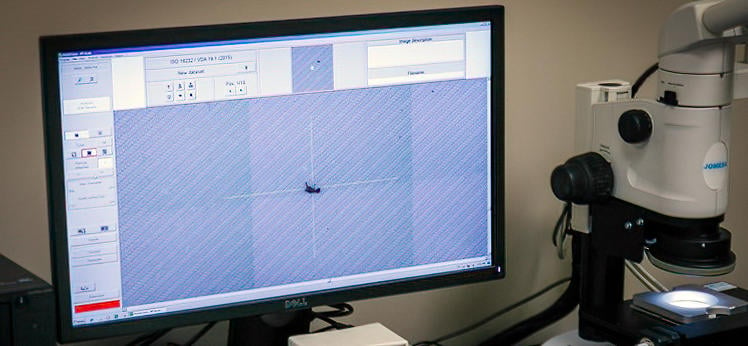In the automotive industry, the cleanliness of engines, transmissions, and braking systems is a critical factor that directly affects performance, reliability, and longevity. Achieving the desired cleanliness specifications requires advanced cleaning processes, and one key element in this process is the filtration efficiency of parts washers. Filtration efficiency refers to the ability of a filtration system to remove particles of various sizes from a fluid, such as the cleaning solution in a parts washer. This blog explains the factors affecting filtration efficiency and the types of filtration used on parts washers.
Factors Affecting Filtration Efficiency
Several factors influence filtration efficiency, and understanding these factors is essential for choosing the right filtration to achieve the desired cleanliness results. Filtration efficiency is a measure of how effectively a filter can capture and retain particles of a certain dimension and size. The higher the filtration efficiency, the cleaner filtrate.
Filter Media
The choice of filter media, such as cellulose, fabric, or membrane, significantly affects filtration efficiency. Different media have varying pore sizes and structures that affect their ability to capture particles of specific sizes. Filters should be purchased from a reliable source, as some cheaper alternatives may not provide the desired filtration levels. Remember the adage, "You get what you pay for”? It holds in this case.
Pore Size
The size of the filter's pores determines what size particles it can capture. Selecting the appropriate pore size is critical to achieve the desired cleanliness levels. A smaller pore size may also impede the flow of fluid leading to increased pressure drops and frequent media replacement. Striking the right balance between particle capture and system flow is essential for optimizing filtration efficiency.
Flow Rate
The rate at which fluid passes through the filter affects its efficiency. Higher flow rates may reduce efficiency, as there is less time to capture particles.
Pressure Drop
As filters capture particles, they also create a resistance to the flow of fluid, leading to a pressure drop. Balancing filtration efficiency with an acceptable pressure drop is a constant challenge in designing effective filtration systems. High-pressure drops can lead to increased energy consumption and decreased overall system efficiency.
Compatibility with Fluids
Certain filtration media may not be suitable for all types of fluids. Compatibility issues can arise, leading to degradation of the filter media or reduced filtration efficiency. Selecting the right filter material for the specific application is crucial for long-term performance.
Filter Maintenance
Filters require regular maintenance to ensure continued high efficiency. Over time, accumulated particles can clog the filter media, reducing its effectiveness. Regular monitoring and replacement of filters are necessary to avoid a decline in filtration efficiency and, consequently, a compromise in cleanliness specifications.
Types of Filters in Parts Washer
The filtration system typically used in a parts washer consists of assorted filters designed to capture particles of different sizes. Implementing a multi-stage filtration system allows for sequential removal of particles, starting with larger contaminants and progressively capturing smaller ones. This approach maximizes filtration efficiency and extends the life of each filter stage.
Mesh filters: These are the first line of defense. Mesh filters trap large particles to protect the wash pumps and spray nozzles and can act as pre-filtration to extend the life of finer downstream filters.
Bag Filters: These are commonly used in parts washers and are effective at capturing larger particles when a maximum contamination weight needs to be met. They are easy to replace and offer a cost-effective solution for coarse filtration. The filtration efficiency of a bag filter is between 50% and 95%, allowing particles larger than the filter's micron size rating to potentially pass through. To meet stringent cleanliness specifications, finer filtration is required.
Cartridge Filters: Provide a higher level of filtration efficiency compared to bag filters but are more expensive. Their filtration efficiency ranges between 90 and 99.9%, and they are capable of capturing a higher amount of smaller particles. Cartridge filters are frequently employed in series as a secondary filtration stage to enhance the filtration of finer particles, ensuring compliance with cleanliness criteria that impose limits on the maximum size of contaminants
Conclusion
Attaining and upholding the desired cleanliness standards for components involves a complex procedure, where filtration efficiency holds a central position. The efficacy of a parts-washing system depends on its capability to efficiently capture contaminants and avoid their redeposition on cleaned parts. By recognizing the significance of filtration efficiency, choosing appropriate filters, and adopting proactive maintenance measures, manufacturers can guarantee that their parts washers consistently meet cleanliness standards. This, in turn, enhances the overall quality and reliability of the finished parts. PROCECO’s experienced team of engineers have the know-how to properly assess your needs and recommend the proper filtration systems to meet your cleaning criteria.
|
Maximize your cleaning performance—contact PROCECO’s parts cleaning experts to find the right filtration system tailored to your production needs! |



